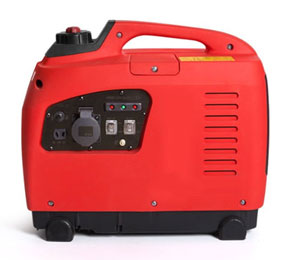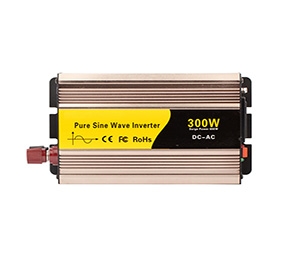In modern society, a continuous power supply is essential for maintaining the normal operation of homes, businesses, and industries. As energy demand grows and technology advances, generators, and inverters have become crucial power devices. Although both have their advantages, many people still wonder about the differences between the two. Inverter.com will explore the principles, working mechanisms, applications, and key factors to consider when choosing between generators and inverters, helping readers better understand the fundamental distinctions between these two devices.
Generators: Core Devices for Converting Mechanical Energy into Electrical Energy
A generator is a device that converts mechanical energy into electrical energy, widely used in industrial, commercial, and household systems. Its working principle is based on Faraday’s law of electromagnetic induction, where an electric current is generated as conductors cut through magnetic lines of force.
1. How Does a Generator Work?
An external power source, such as fuel-driven engines, wind turbines, or water turbines typically drives generators. When these power sources rotate the generator’s rotor, the magnetic field in the stator induces a current in the coils, creating electricity. This generated current can be either alternating current (AC) or direct current (DC), depending on the design of the generator.
Fuel Sources: Most portable generators run on gasoline or diesel, while larger industrial generators may use coal, natural gas, or nuclear power. These fuels produce mechanical energy through internal combustion engines or turbines, which are then converted into electrical output.
These fuels produce mechanical energy through internal combustion engines or turbines, which are then converted into electrical output.
2. Types of Generators
Generators can be classified into various types based on different standards, with the most common being:
- AC Generators (Alternating Current): These are the most prevalent types, used in power plants, industrial applications, and household systems. They output alternating current, which is suitable for most home appliances and devices.
- DC Generators (Direct Current): These generators provide direct current and are primarily used for specific industrial applications such as electroplating, battery charging, and powering motors.
- Portable Generators: Typically used for emergency power or outdoor activities, these are compact, easy to operate, and suitable for powering small household appliances.
- Inverter Generators: Inverter generators also produce AC power but use inverter technology to first convert AC to DC and then back to AC. This produces a smoother and more stable electrical output, making it ideal for sensitive devices requiring high-quality power.
3. Main Applications of Generators
Generators are efficient at producing electricity and are widely used in the following scenarios:
- Emergency Power Supply: In the event of a power outage, generators can quickly provide temporary power, ensuring basic electrical needs for homes and businesses are met.
- Construction Sites: Since construction sites often lack stable power sources, portable generators are essential for powering tools and machinery.
- Outdoor Activities: When camping or working outdoors, portable generators can power lighting, cooking appliances, and communication devices.
- Industrial Power Generation: Large generators are used in power stations to provide large-scale electricity for cities or factories.
Inverters: Key Devices for Power Conversion
Unlike generators, an inverter is an electric conversion device whose main function is to convert direct current (DC) into alternating current (AC). DC power typically comes from batteries or solar power systems, while AC is the form of electricity used in most day-to-day applications. Inverters play a crucial role in bridging this gap in various scenarios.
1. How Does an Inverter Work?
 The core working principle of an inverter involves the use of electronic switches that rapidly toggle the direction of current flow to simulate the waveform of AC. The process includes the following steps:
The core working principle of an inverter involves the use of electronic switches that rapidly toggle the direction of current flow to simulate the waveform of AC. The process includes the following steps:
DC Input: DC power from a battery, solar panel, or other DC source is fed into the inverter.
Switching and Control Circuit: The inverter’s switches (typically transistors or MOSFETs) rapidly change the current’s direction, producing a waveform that approximates AC.
Filtering and Shaping: Filters are used to smooth the waveform and regulate the frequency, bringing the output AC closer to the sine waveform required by household and industrial appliances.
2. Types of Inverters
Inverters are primarily classified by the type of output waveform they produce:
- Square Wave Inverter: This type generates a simple waveform and is suitable for devices that don't require high-quality power, such as lights or basic electrical tools.
- Modified Sine Wave Inverter: This produces a waveform smoother than a square wave and is suitable for most household appliances and power tools.
- Pure Sine Wave Inverter: Pure sine wave inverter outputs the smoothest waveform, perfectly replicating the AC power from the grid. It’s essential for devices that demand high-quality power, such as medical equipment and precision electronics.
3. Main Applications of Inverters
Inverters are crucial in several fields, especially where AC power is not directly available:
- Solar Power Systems: Solar panels generate DC power, which is converted by inverters into AC power for homes and businesses.
- Car Power Supplies: Many vehicle electronic devices, like TVs, phone chargers, and laptops, depend on inverters to convert DC power from the car’s battery into usable AC power.
- Backup Power Systems: In cases of power outages, inverters can convert stored battery energy into AC, maintaining the operation of household appliances.
Key Differences Between Generators and Inverters
While both generators and inverters are closely related to power supply and conversion, their functions and applications are distinct. Here are the core differences between them:
- Working Principle
Generator: Produces power by converting mechanical energy into electrical energy, relying on external fuel or power sources.
Inverter: This does not generate power but converts DC into AC, relying on existing power sources like batteries or solar panels.
- Type of Electrical Output
Generator: This can output either AC or DC power, depending on the design and application.
Inverter: Specifically designed to convert DC power to AC, with the quality of the output depending on the inverter type.
- Application Scenarios
Generator: Suitable for power stations, construction sites, emergency power, and other applications that require independent power output.
Inverter: Used in solar systems, vehicles, or backup power systems to convert and distribute existing electrical energy.
- Device Dependence
Generator: Operates independently and can generate electricity without relying on external power.
Inverter: Requires an existing power source (e.g., battery) and cannot generate electricity on its own.
Both generators and inverters have significant roles in the power equipment field, each offering unique advantages. Generators are capable of independent power generation, making them ideal for environments where electricity supply is lacking, especially in emergencies. Inverters, on the other hand, are crucial for converting DC power into AC, making them essential in solar systems, vehicle power supplies, and backup power systems. As far as Home Power Inverter is concerned, understanding the principles and application scenarios of both devices allows users to select the most suitable equipment based on their needs, optimizing power supply and usage efficiency.
